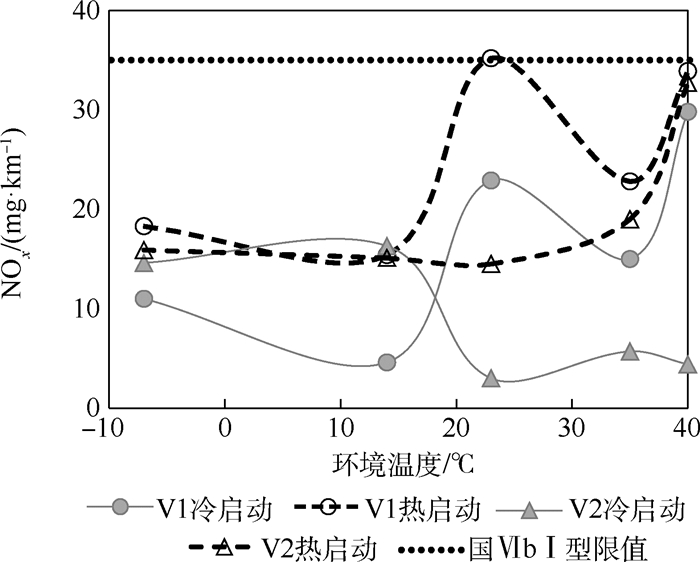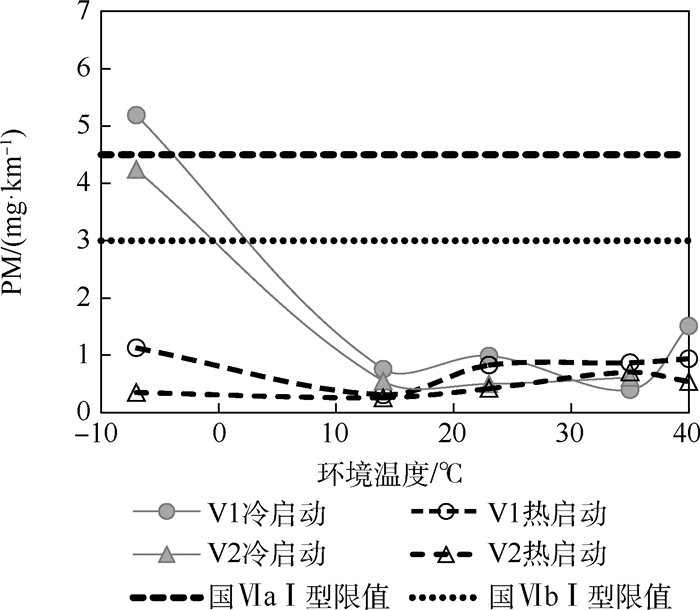-
摘要:
选取2辆典型汽油缸内直喷汽车(GDIV),在环境舱内进行了不同环境温度下,车辆冷启动和热启动后按照全球轻型车统一测试循环(WLTC)运行时的排气污染物试验,测量并分析了GDIV排气中的气态污染物和颗粒物,旨在为GDIV排放系统设计、控制策略制定以及评价汽车排放对环境影响的相关研究提供理论依据。研究结果表明:环境温度对GDIV试验车辆冷启动和热启动的颗粒物数量(PN)和颗粒物质量(PM)排放因子影响显著。环境温度低于14℃,冷启动工况下行驶时PN排放难以满足国Ⅵ排放标准限值,总碳氢化合物(THC)和CO的排放因子受温度的影响显著,热启动时影响不明显。无论是热启动还是冷启动工况,当温度从-7℃逐步上升到40℃时,试验车辆的CO2排放因子呈现先减少后增加的变化规律,2辆车在热启动时的CO2排放因子比冷启动时平均降低4%和7%。冷启动和热启动时,氮氧化物(NO
x )排放因子受温度的影响均没有明显的规律。-
关键词:
- 环境温度 /
- 气体排放 /
- 颗粒物排放 /
- 汽油缸内直喷式发动机 /
- 汽油车
Abstract:Two typical Gasoline Direct Injection Vehicles (GDIVs) were selected, and emission tests in the environmental cabin were performed under Worldwide harmonized Light-duty rehicles Test Cycle (WLTC) at different ambient temperatures after the vehicles cold-started and hot-started. The gaseous pollutants and particulates in GDIV emissions were measured and analyzed with the aim of providing a theoretical basis for the GDIV emission system design and control, as well as for related research to evaluate the impact of automobile emissions on the environment. The results show that ambient temperature has a significant effect on the Particle Number (PN) and Particle Matter (PM) emission factor of the tested vehicles. The PN emission factor under the cold start condition is difficult to meet the China 6 emission limit when ambient temperature is below 14℃. The emission factors of Total Hydrocarbons (THC) and CO are significantly affected by temperature under cold start condition but are not significantly affected under hot start condition. Regardless of the hot start or cold start conditions, when the temperature gradually rises from -7℃ to 40℃, the CO2 emission factor of the test vehicle first decreases and then increases, and the CO2 emission factor of the two vehicles during hot start is reduced by 4% and 7% on average compared to cold start. There is no obvious rule of Nitrogen Oxide (NO
x ) emission factor influenced by temperature under cold start and hot start conditions. -
表 1 试验车辆及其主要性能参数
Table 1. Test vehicles and their main performance parameters
参数 V1 V2 供油方式 GDI GDI 进气方式 自然吸气 涡轮增压 排量/L 3 2 最大功率/kW 172 155 变速箱 AT AT 工信部油耗/(L·(100 km)-1) 9.8 7.1 整备质量/kg 2 291 1 581 -
[1] 李兴虎. 汽车的环境污染与防治技术[M]. 北京: 化学工业出版社, 2019: 42-257.LI X H.Automobile environmental pollution and prevention technology[M]. Beijing: Chemical Industry Press, 2019: 42-257(in Chinese). [2] BOGARRA M, HERREROS J M, TSOLAKIS A, et al. Study of particulate matter and gaseous emissions in gasoline direct injection engine using on-board exhaust gas fuel reforming[J]. Applied Energy, 2016, 180(19): 245-255. [3] 环境保护部. 轻型汽车污染物排放限值及测量方法(中国第六阶段): GB18352.6-2016[S]. 北京: 中国环境科学出版社, 2016: 6-12.Ministry of Environmental Protection.Limits and measurement methods for emissions from light-duty vehicles (China 6): GB 18352.6-2016[S].Beijing: China Environmental Science Press, 2016: 6-12(in Chinese). [4] 宋艳慧. 三效催化转化器起燃特性的试验研究与数值模拟[D]. 西安: 长安大学, 2008: 19-24.SONG Y H.The test study and numerical simulation of the light-off characteristic of three-way catalytic converter[D].Xi'an: Chang'an University, 2008: 19-24(in Chinese). [5] Delphitechnologies.Worldwide emissions standards-passenger cars and light duty vehicles[EB/OL].(2019-05-19)[2020-01-14]. [6] ANDREWS G E, LI H, WYLIE J A, et al.Influence of ambient temperature on cold-start emissions for a Euro 1 SI car using in-vehicle emissions measurement in an urban traffic jam test cycle: 2005-01-1617[R].Detroit: SAE International, 2005: 1-21. [7] 王猛, 赵陆明, 刘文亮, 等. 直喷汽油车在低温环境下颗粒数量排放特性研究[J]. 车辆与动力技术, 2017(4): 49-51. doi: 10.3969/j.issn.1009-4687.2017.04.011WANG M, ZHAO L M, LIU W L, et al. Emission characteristics of particle number for direct injection gasoline car in low temperature environment[J]. Vehicle & Power Technology, 2017(4): 49-51(in Chinese). doi: 10.3969/j.issn.1009-4687.2017.04.011 [8] ZHU R C, HU J N, BAO X F, et al. Tailpipe emissions from gasoline direct injection (GDI) and port fuel injection (PFI) vehicles at both low and high ambient temperatures[J]. Environmental Pollution, 2016, 216: 223-234. doi: 10.1016/j.envpol.2016.05.066 [9] YUSUF A A, INAMBAO F L.Effect of cold start emissions from gasoline-fueled engines of light-duty vehicles at low and high ambient temperatures: Recent trends[J]. Case Studies in Thermal Engineering, 2019, 14: 1-10. [10] BIELACZYCP, WOODBURN J, SZCZOTKA A.Investigations into particulate emissions from euro 5 passenger cars with disi engines tested at multiple ambient temperatures: 2015-24-2517[R].Napoli: SAE International, 2015: 1-10. [11] CHAN T W, MELOCHE E, KUBSH J, et al. Impact of ambient temperature on gaseous and particle emissions from a direct injection gasoline vehicle and its implications on particle filtration[J]. SAE International Journal of Fuels and Lubricants, 2013, 6(2): 350-371. doi: 10.4271/2013-01-0527 [12] 韩渊丰, 张加恭, 张争胜. 中国区域地理[M]. 广州: 广东高等教育出版社, 2008: 1-3.HAN Y F, ZHANG J G, ZAHNG Z S.Chinese regional geography[M]. Guangzhou: Guangdong Higher Education Press, 2008: 1-3(in Chinese). [13] 王银辉. 汽油组分对直喷汽油机一次和二次颗粒物生成影响的研究[D]. 北京: 清华大学, 2016: 4-28.WANG Y H.The impact of fuel compositions on primary and secondary particulate formation of gasoline direct injection engines[D].Beijing: Tsinghua University, 2016: 4-28(in Chinese). [14] WEILENMANN M, SOLTIC P, SAXER C, et al. Regulated and nonregulated diesel and gasoline cold start emissions at different temperatures[J]. Atmospheric Environment, 2005, 39(13): 2433-2441. doi: 10.1016/j.atmosenv.2004.03.081 [15] MULAWA P A, CADLE S H, KNAPP K, et al. Effect of ambient temperature and e-10 fuel on primary exhaust particulate matter emissions from light-duty vehicles[J]. Environmental Science & Technology, 1997, 31(5): 1302-1307. doi: 10.1021/es960514r [16] POLAT S, UYUMAZ A, SOLMAZ H, et al. Numerical study on the effects of EGR and spark timing to combustion characteristics and NOx emission of a GDI engine[J]. International Journal of Green Energy, 2014, 13(1): 63-70. doi: 10.1080/15435075.2014.909361 -








 下载:
下载:









